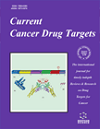- Home
- A-Z Publications
- Current Cancer Drug Targets
- Previous Issues
- Volume 11, Issue 8, 2011
Current Cancer Drug Targets - Volume 11, Issue 8, 2011
Volume 11, Issue 8, 2011
-
-
The Phosphoinositide 3-Kinase Signaling Pathway as a Therapeutic Target in Grade IV Brain Tumors
More LessBrain tumors comprise a wide variety of neoplasia classified according to their cellular origin and their morphological and histological characteristics. The transformed phenotype of brain tumor cells has been extensively studied in the past years, achieving a significant progress in our understanding of the molecular pathways leading to tumorigenesis. It has been reported that the phosphoinositide 3-kinase (PI3K)/A Read More
-
-
-
Pharmacological Characterization of Histone Deacetylase Inhibitor and Tumor Cell-Growth Inhibition Properties of New Benzofuranone Compounds
More LessAuthors: C. Blanquart, M. Francois, C. Charrier, P. Bertrand and M. GregoireEpigenetic modifications, such as DNA methylation or histone deacetylation, are early events in cell tumorigenesis. The consequences of these modifications are repression of gene transcription and, notably, of tumor suppressor gene transcription. New therapeutic strategies aim to ‘normalize’ the epigenetic status of cancer cells. Histone deacetylase inhibitors (HDACi) have shown promising effects against proliferati Read More
-
-
-
L-Asparaginase and Inhibitors of Glutamine Synthetase Disclose Glutamine Addiction of β-Catenin-Mutated Human Hepatocellular Carcinoma Cells
More LessAuthors: S. Tardito, M. Chiu, J. Uggeri, A. Zerbini, F. Da Ros, V. Dall'Asta, G. Missale and O. BussolatiSelected oncogenic mutations support unregulated growth enhancing glutamine availability but increasing the dependence of tumor cells on the amino acid. Data from literature indicate that a subset of HepatoCellular Carcinomas (HCC) is characterized by mutations of β-catenin and overexpression of Glutamine Synthetase (GS). To assess if this phenotype may constitute an example of glutamine addiction, we treated Read More
-
-
-
Comparing the Efficacy of Sunitinib with Sorafenib in Xenograft Models of Human Hepatocellular Carcinoma: Mechanistic Explanation
More LessAuthors: H. Huynh, S. P. Choo, H. C. Toh, W. M. Tai, A. Y.F. Chung, P. K.H. Chow, R. Ong and K. C. SooHepatocellular carcinoma (HCC) is the fifth most common and third deadliest malignancy. Sorafenib has demonstrated 44% survival advantage over placebo and has emerged as a standard of care in advanced HCC. The therapeutic effects of sorafenib are however transient and hence additional treatment options are warranted. In this study, we aimed to compare the efficacy of sunitinib relative to sorafenib, two potent Read More
-
-
-
Active-Targeted Nanotherapy Strategies for Prostate Cancer
More LessAuthors: M. Katsogiannou, L. Peng, C. V. Catapano and P. RocchiCastration-resistant prostate cancer remains incurable and a major cause of mortality worldwide. The absence of effective therapeutic approaches for advanced prostate cancer has led to an intensive search for novel treatments. Emerging nanomedical approaches have shown promising results, in vitro and in vivo, in improving drug distribution and bioavailability, tumor penetration and in limiting toxicity. Nanoscaled carrie Read More
-
-
-
H+-myo-Inositol Transporter SLC2A13 as a Potential Marker for Cancer Stem Cells in an Oral Squamous Cell Carcinoma
More LessAuthors: D. G. Lee, J.-H. Lee, B. K. Choi, M.-J. Kim, S.-M. Kim, K. S. Kim, K. Chang, S. H. Park, Y.-S. Bae and B. S. KwonCancer Stem Cells (CSCs) from tumors of different phenotypes possess a marked capacity for proliferation, self-renewal, and differentiation. They also play a critical role in cancer recurrence. Although CSC has been regarded as a new target for cancer therapy, the fundamental questions in the CSC study have not been resolved mainly due to the lack of proper CSC markers. To find new CSC markers for oral squamous cell ca Read More
-
-
-
RNAi Screening Identifies TAK1 as a Potential Target for the Enhanced Efficacy of Topoisomerase Inhibitors
More LessAuthors: S. E. Martin, Z.-H. Wu, K. Gehlhaus, T. L. Jones, Y.-W. Zhang, R. Guha, S. Miyamoto, Y. Pommier and N. J. CaplenIn an effort to develop strategies that improve the efficacy of existing anticancer agents, we have conducted a siRNA-based RNAi screen to identify genes that, when targeted by siRNA, improve the activity of the topoisomerase I (Top1) poison camptothecin (CPT). Screening was conducted using a set of siRNAs corresponding to over 400 apoptosisrelated genes in MDA-MB-231 breast cancer cells. During the course of these studie Read More
-
-
-
Reactivation of p53 by Inhibiting Mdm2 E3 Ligase: A Novel Antitumor Approach
More LessThe p53 tumor suppressor has been pursued as a cancer therapeutic target based on its ability to induce cell cycle arrest and apoptosis. Reactivation of p53 in the approximately 50% of tumors that retain a functional p53 has served as potential approach in the development of cancer drug therapy. Mdm2 is a major negative regulator of p53 and has long been thought to inhibit p53 in two ways: through ubiquitination of Read More
-
Volumes & issues
-
Volume 25 (2025)
-
Volume 24 (2024)
-
Volume 23 (2023)
-
Volume 22 (2022)
-
Volume 21 (2021)
-
Volume 20 (2020)
-
Volume 19 (2019)
-
Volume 18 (2018)
-
Volume 17 (2017)
-
Volume 16 (2016)
-
Volume 15 (2015)
-
Volume 14 (2014)
-
Volume 13 (2013)
-
Volume 12 (2012)
-
Volume 11 (2011)
-
Volume 10 (2010)
-
Volume 9 (2009)
-
Volume 8 (2008)
-
Volume 7 (2007)
-
Volume 6 (2006)
-
Volume 5 (2005)
-
Volume 4 (2004)
-
Volume 3 (2003)
-
Volume 2 (2002)
-
Volume 1 (2001)
Most Read This Month
Article
content/journals/ccdt
Journal
10
5
false
en


